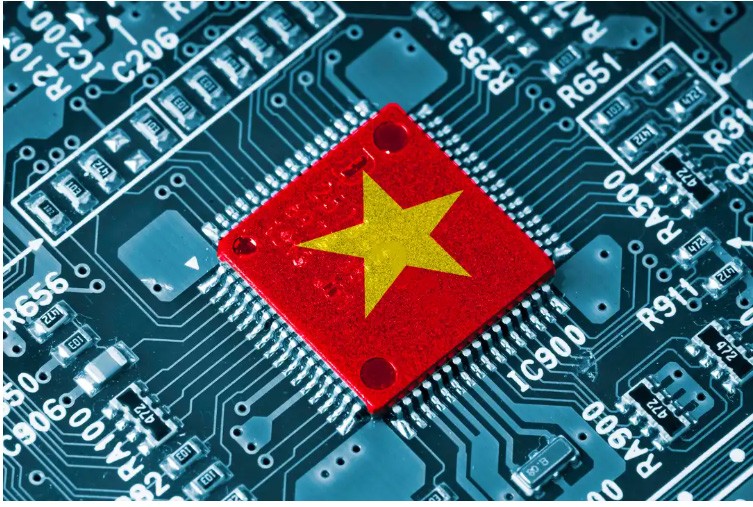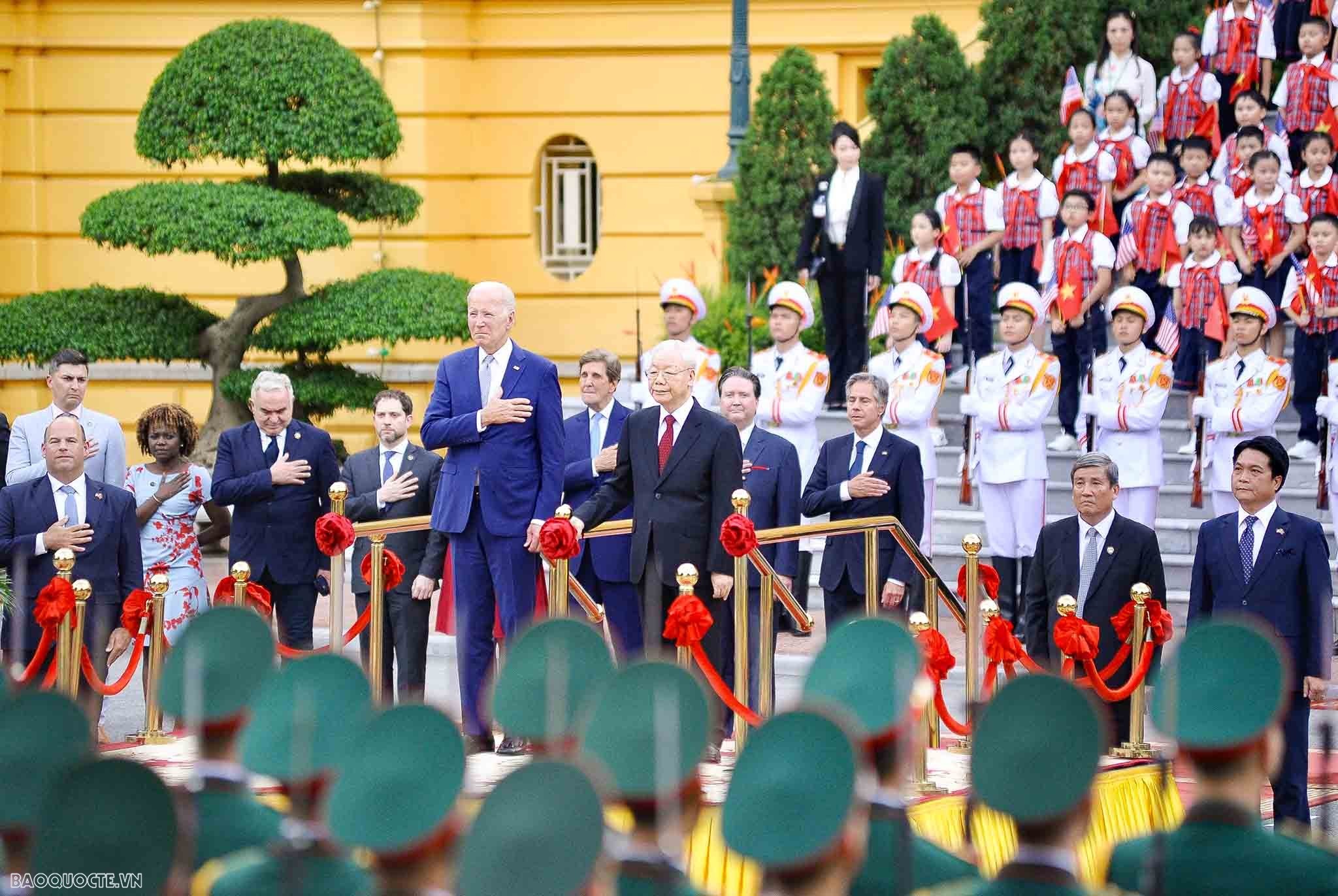
Vietnam – country with roaring growth and higher rank in global supply chain: media
Latest
 |
| Vietnam's flag on Microchip processor on electronic board for important component in computer smartphone. (Photo: Getty Images) |
Unlocking Vietnam's economic potential
In the commentary titled “Unlocking Vietnam's Economic Potential”, Seeking Alpha, an Israel-based content service that publishes news on financial markets said that Vietnam is becoming an increasingly attractive investment destination thanks to its sturdy GDP growth, strides in its high-tech manufacturing capabilities, and strong US ties.
This website explores what makes Vietnam an attractive investment destination are the economic resilience, the higher rank in the value chain ladder, strong foreign investment and strides in high-tech manufacturing, particularly semiconductors, positioning itself in the global supply chain.
It said that Vietnam’s GDP grew by 8.0% in 2022 as the country’s economy benefited from exports of goods during the COVID-19 pandemic. This year Vietnam’s economy has stabilized at a GDP growth of 5.3% year-over-year (YoY) in 3Q 2023.
The country’s economy has been fairly resilient despite headwinds from higher commodity prices resulting from the Russia-Ukraine war and a slowdown in China, which happens to be one of Vietnam’s largest trading partner.
Vietnam's trade faced some headwinds this year due to reduced demand from major trade partners. Exports fell 10% YoY2 in the first eight months of 2023 and finally turned positive in September.
Seeking Alpha sees that Vietnam’s government is actively trying to lure foreign investments in high-tech manufacturing particularly in the semiconductor sector. The country has signed multiple Free Trade Agreements (FTAs) to encourage foreign cooperation with its local industries and offered supportive measures such as tax incentives, preferential loan rates, waived import duties and preferential land use fees for high tech factories.
Strong government support appears to be yielding some early results, the website noted. The country has achieved impressive growth in electronics exports, notably to the United States. From virtually zero, Vietnam now accounts for around 10% of all U.S. electronics imports.
Despite facing a challenging environment characterized by sluggish growth and lackluster export performance throughout the year, Vietnam has managed to attract $15.9 billion in Foreign Direct Investment (FDI) YTD. The manufacturing sector maintained its position as the primary attraction for FDI, with investments exceeding $14 billion YTD, reflecting a substantial gain of 15.5% YoY.
This achievement is significant given the prevailing uncertainty, inflationary pressures, and waning confidence in the global economic landscape. Key Apple suppliers such as Foxconn Technology Group (OTCPK:FXCOF), GoerTek Inc., Luxshare Precision Industry Co., and Pegatron Corp. have set up factories in Vietnam; bringing electonics industry share of total exports to 32% in 2022.
Also according to the website, Vietnam has the world’s second largest reserves of rare earths, estimated at 22 million tonnes second only to China. Its rare earths industry is booming with 2022 production of 4,300 tonnes up about 11 times relative to its 2021 production of only 400 tonnes.7 The country aims to raise its rare earths production to 2.02 million tonnes a year by 2030.
Foreign companies including Korean and Chinese magnet firms, which include an Apple (AAPL) supplier are set to open factories in Vietnam to diversify supply chains away from China, it added.
Vietnam and the US recently signed the Comprehensive Economic Partnership agreement to enhance cooperation between the two countries in a wide range of industries. The US is committing seed funding of $2 million to kickstart the semiconductor workforce development initiatives in Vietnam.
Semiconductors are a critical component in various technologies, and this collaboration aims to improve Vietnam's position in the global supply chain for semiconductors, indicating the significant role Vietnam is poised to play in the industry's growth.
 |
| President Joe Biden visited Hanoi in September 2023. |
In conclusion, Seeking Alpha stated that Vietnam stands at the threshold of an exciting economic transformation. The nation has demonstrated impressive resilience, attracting foreign investments and fostering growth in high-value sectors.
With substantial rare earth reserves and a growing semiconductor sector, Vietnam is poised to become a vital player in global supply chains. The strong partnership between the U.S. and Vietnam further solidifies the nation's position in the global economic landscape.
Investors looking for growth opportunities should keep an eye on Vietnam as it climbs the value chain and expands its presence in strategic sectors, making it a compelling investment destination, it stated.
New tiger economy is roaring
Previously, MoneyWeek, one of UK's best selling financial magazine, has posted an article on Vietnam’s growth story, in which it said Vietnam has become a thriving regional hub with ample scope for further rapid development.
According to the magazine, the implementation of “Doi Moi” policy starting from 1986, the admission into the Association of Southeast Asian Nations (ASEAN), the main regional bloc in 1995, the normalization of the bilateral relation between Vietnam and the US in 2000 and Vietnam’s accession to the WTO followed in 2007 as well as the participation and signing of a series of free trade agreements are considered as the milestones that have helped transform Vietnam into a country of middle-income status.
It noted that within a single generation, with GDP per capita rising 3.6 times in the two decades after 2002. In 1986 exports of goods and services represented less than 7% of Vietnam’s GDP; by 2021 that figure had risen to 93%.
As shared by Yuji Nitta in Nikkei Asia, over that period Vietnam has enjoyed three distinct booms in foreign investment. The first began in the mid-1990s when Honda Motor of Japan started “local two-wheeler production” and global sportswear brands moved in to set up local factories. Then the early 2000s saw tech firms from elsewhere in Asia establish production lines for simple electronics. Finally, in the mid-2010s, rising local incomes began to tempt in foreign retail businesses, such as Japanese “shopping behemoth” Aeon.
The overall effect has been to create an export powerhouse. As Jeff Prestridge notes in the Mail on Sunday, “more than half of Nike’s shoes and 60% of Samsung’s phones are made in Vietnam”.
According to MoneyWeek, Vietnam is intent on pivoting from “labor-intensive” textiles and electrical assembly work into more profitable sectors, such as semiconductors.
Foreign capital is keen to help, given the growing pressure to diversify supply chains away from China. US business investment has historically been more limited than that coming from Japan and South Korea, but a visit by President Joe Biden to Hanoi in September, at which the two countries upgraded ties to a “Comprehensive Strategic Partnership”, should act as a “green light” for increased investment from corporate America.
The magazine also quoted Andy Ho of the VinaCapital Vietnam Opportunity Fund telling The Sunday Times that the country’s “competitive advantage is plain to see”. Factory wages “are less than half those of China, while the quality of the workforce is comparable in many sectors”. The country is also geographically close to key technology supply chains in southern China.
About 75% of the bill for materials in a typical smartphone is made up of the combined cost of the printed circuit board, camera module, touch screen and glass cover. Vietnamese manufacturers can source most of these parts from elsewhere in Asia with zero tariffs, thanks to the country’s network of free-trade deals. Their Indian rivals, meanwhile, must contend with customs duties as high as 22%.
The financial magazine added that Vietnam has been dubbed the new Asian tiger, bringing to mind the rapid development of South Korea, Taiwan, Hong Kong and Singapore in the latter half of the 20th century. Vietnamese investors certainly hope that the country can emulate the example of the earlier tigers to climb into the high-income bracket, defined by the World Bank as those countries with a gross national income per capita above $13,845.

























